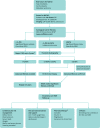Non-alcoholic fatty liver disease
- PMID: 29858436
- PMCID: PMC6334080
- DOI: 10.7861/clinmedicine.18-3-245
Non-alcoholic fatty liver disease
Abstract
Non-alcoholic fatty liver disease (NAFLD) has a global prevalence of about 25%. Incidence is increasing with rising levels of obesity, type 2 diabetes and the metabolic syndrome, and NAFLD is predicted to become the leading cause of cirrhosis requiring liver transplantation in the next decade. However, the cardiovascular disease is the most common cause of death and only a minority will develop fibrosis and liver-related complications. Therefore, it is imperative to identify patients with advanced disease using non-invasive markers of fibrosis, which include serology-based tests (eg NAFLD Fibrosis Score and ELF test) and imaging (eg transient elastography). This targets appropriate patients for referral to secondary care for additional investigations such as liver biopsy and specialist care. Lifestyle modification and weight loss remains the cornerstone of management, but we are about to enter a new era of promising pharmacotherapies for NASH and fibrosis.
Keywords: diagnosis; fibrosis; liver disease; management; non-alcoholic fatty liver disease.
© Royal College of Physicians 2018. All rights reserved.
Figures


Comment in
-
Vitamin E - a cause for concern?Clin Med (Lond). 2018 Oct;18(5):439-440. doi: 10.7861/clinmedicine.18-5-439a. Clin Med (Lond). 2018. PMID: 30287449 Free PMC article. No abstract available.
-
Response.Clin Med (Lond). 2018 Oct;18(5):440. doi: 10.7861/clinmedicine.18-5-440. Clin Med (Lond). 2018. PMID: 30287450 Free PMC article. No abstract available.
Similar articles
-
Liver fibrosis in non-alcoholic fatty liver disease - diagnostic challenge with prognostic significance.World J Gastroenterol. 2015 Oct 21;21(39):11077-87. doi: 10.3748/wjg.v21.i39.11077. World J Gastroenterol. 2015. PMID: 26494963 Free PMC article. Review.
-
Noninvasive evaluation of nonalcoholic fatty liver disease: Current evidence and practice.World J Gastroenterol. 2019 Mar 21;25(11):1307-1326. doi: 10.3748/wjg.v25.i11.1307. World J Gastroenterol. 2019. PMID: 30918425 Free PMC article. Review.
-
AGA Clinical Practice Update on the Role of Noninvasive Biomarkers in the Evaluation and Management of Nonalcoholic Fatty Liver Disease: Expert Review.Gastroenterology. 2023 Oct;165(4):1080-1088. doi: 10.1053/j.gastro.2023.06.013. Epub 2023 Aug 4. Gastroenterology. 2023. PMID: 37542503 Review.
-
Mechanisms, screening modalities and treatment options for individuals with non-alcoholic fatty liver disease and type 2 diabetes.Diabet Med. 2020 Nov;37(11):1793-1806. doi: 10.1111/dme.14356. Epub 2020 Jul 13. Diabet Med. 2020. PMID: 32619031 Review.
-
Epidemiology and natural history of non-alcoholic fatty liver disease.Metabolism. 2016 Aug;65(8):1017-25. doi: 10.1016/j.metabol.2016.01.012. Epub 2016 Jan 29. Metabolism. 2016. PMID: 26997539 Review.
Cited by
-
Anxiety and Depression in Metabolic-Dysfunction-Associated Fatty Liver Disease and Cardiovascular Risk.J Clin Med. 2022 Apr 28;11(9):2488. doi: 10.3390/jcm11092488. J Clin Med. 2022. PMID: 35566616 Free PMC article.
-
Long non-coding RNA GAS5 contributes to the progression of nonalcoholic fatty liver disease by targeting the microRNA-29a-3p/NOTCH2 axis.Bioengineered. 2022 Apr;13(4):8370-8381. doi: 10.1080/21655979.2022.2026858. Bioengineered. 2022. PMID: 35322757 Free PMC article.
-
The pro-inflammatory marker soluble suppression of tumorigenicity-2 (ST2) is reduced especially in diabetic morbidly obese patients undergoing bariatric surgery.Cardiovasc Diabetol. 2020 Feb 26;19(1):26. doi: 10.1186/s12933-020-01001-y. Cardiovasc Diabetol. 2020. PMID: 32101157 Free PMC article.
-
Relationship between sarcopenia and fatty liver in middle-aged and elderly patients with type 2 diabetes mellitus.J Orthop Surg Res. 2024 Apr 20;19(1):250. doi: 10.1186/s13018-024-04717-9. J Orthop Surg Res. 2024. PMID: 38643133 Free PMC article.
-
Correlation between serum uric acid to high-density lipoprotein cholesterol ratio and atrial fibrillation in patients with NAFLD.PLoS One. 2024 Jun 24;19(6):e0305952. doi: 10.1371/journal.pone.0305952. eCollection 2024. PLoS One. 2024. PMID: 38913677 Free PMC article.
References
-
- Younossi ZM. Koenig AB. Abdelatif D, et al. Global epidemiology of nonalcoholic fatty liver disease – Meta-analytic assessment of prevalence, incidence, and outcomes. Hepatology. 2016;64:73–84. - PubMed
-
- Ekstedt M. Hagström H. Nasr P, et al. Fibrosis stage is the strongest predictor for disease-specific mortality in NAFLD after up to 33 years of follow-up. Hepatology. 2015;61:1547–54. - PubMed
Publication types
MeSH terms
Substances
LinkOut - more resources
Full Text Sources
Other Literature Sources
Medical

